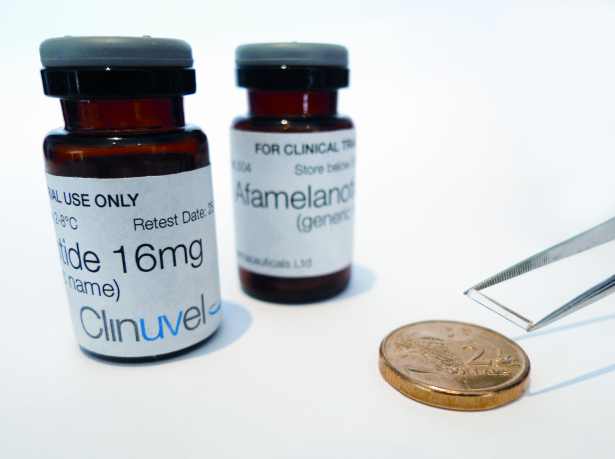
There are many theories regarding the causes of Vitiligo and the process through which this disease spreads, however studies have demonstrated that the loss of cutaneous melanocytes can be caused by decreased circulating and lesional skin levels of the naturally occurring melanocortin peptide hormone, alpha-melanocyte (α-MSH).
The Afamelanotide peptide was developed as a synthetic analogue of α-MSH and has been shown to induce skin pigmentation through melanogenesis and thereby subsequently reduce sun (UV) damage to UV exposed skin.
While this peptide’s origins can be traced back to 1991 there haven’t been many breakthroughs regarding the repigmentation properties that are of interest for the treatment of Vitiligo.
Afamelanotide is the International Nonproprietary Name for the molecule [Nle4, D-Phe7]α-MSH initially researched and developed as melanotan-1 and later, CUV1647 by Clinuvel. A subsequent analogue for Melanotan-1 was developed under the name Melanotan II. Products that bear the name Melanotan II are currently sold as self-tanning injectable supplements on the internet but are not FDA approved. There is also a large community (melanotan.org) of Melanotan II users that have documented the results obtained while using Melanotan II subcutaneous injections or nasal spray for self-tanning purposes.
On the 5th of september 2007 The U.S. Food and Drug Administration (FDA) has issued a Warning Letter for the illegal sale and marketing of the product Melanotan II. „FDA recommends that consumers who are currently using Melanotan II stop using this product and consult their health care provider if they have experienced any adverse events that they suspect are related to its use.”
The Australian company, Clinuvel that first announced clinical trials for vitiligo repigmentation has since then published the trial results at the end of 2012.
Regarding the commencement of its INSPIRE (International SCENESSE® Pilot Repigmentation Evaluation) program to evaluate the use of its first-in-class drug SCENESSE® (afamelanotide) as a repigmentation therapy in vitiligo, Dr Mark Lebwohl, Professor and Chair of Dermatology at Mount Sinai Hospital in New York and an investigator on the Clinuvel study, said: “I think this is an exciting, major advancement for vitiligo, a disease for which we do not have adequate effective treatments,”. “We were thrilled with the speed at which the pigment returned.”

The method Clinuvel uses to administer the afamelanotide peptide is by subcutaneous implant. This method of administering the peptide, combined with narrowband UV-B (NB-UV-B) phototherapy has been shown to induce faster and deeper repigmentation. To quote from the article: „All patients experienced follicular and confluent areas of repigmentation within 2 days to 4 weeks after the initial implant, which progressed significantly throughout treatment. All patients experienced diffuse hyperpigmentation.”
In case you were wondering what an afamelanotide implant is and the implications of this procedure we have gathered some information provided by the recepients of such implants.
The implant is about 10mm by maybe 3mm, white and sort of waxy looking. The recipient is given an injection of anaesthetic in the right lower abdomen, an incision is made and the implant is inserted below the skin with a pair of forceps and then the area is stitched up. There may be a visible scar that fades away with time and the implant can be felt under the skin until it is completely absorbed.
While this treatment is not available yet, Clinuvel is undergoing all legal steps to introduce it in the near future as a treatment for a number of conditions such as Porphyria, Vitiligo, Photodermatoses &Skin Cancer prevention.
PHOTO SOURCE: http://www.technologyreview.in/biomedicine/24960/